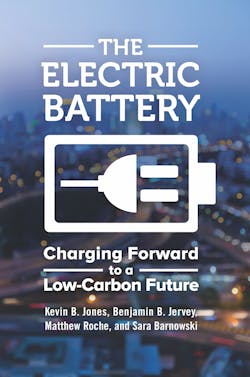Follow the Electric Battery Revolution to California — With or Without Trump
With or without support from the Trump Administration, the electric battery revolution is here to stay, and to accelerate that movement, we need only look to California.
“The Electric Battery” cover
That’s the word from Kevin Jones, director of the Institute for Energy and the Environment at Vermont Law School, and co-author of the recently released “The Electric Battery: Charging Forward to a Low-Carbon Future,” which looks at the technology and policy issues that could allow the electric battery to provide for a low-carbon future. The book takes a look at electric vehicles (EVs), behind-the-meter battery uses and microgrid and grid-level technologies.
Right now, one of the biggest challenges to swift adaptation of the electric battery is the Trump Administration, Jones said in an interview. But the battery is here to stay, with or without the administration’s support
“I think a national carbon tax would be fabulous,” Jones said. But, given that federal carbon taxes or cap-and-trade legislation right now is unlikely, states like California are moving the battery market forward.
“We don’t have to look further than California to see the policies that would be necessary to accelerate the market,” Jones said. “California is doing for the storage market what other states are doing for the solar industry.”
California’s investment in energy storage is just one of the state’s important efforts, and is lowering the cost of storage, he said. The state in 2013 mandated that the state’s investor-owned utilities add 1.3 GW of storage by the end of the decade.
Another “enlightened” effort from California is the state’s time-of-use rates, he said.
“California’s time-of-use rates are shrinking the peak period and increasing the differential between off-peak and on-peak rates,” he said. That allows EV owners and battery owners to charge batteries when rates are lowest.
Another plus is the Self-Generation Incentive Program, under which the state provides incentives to boost distributed generation. Recently, the state pointed to the benefits of energy storage for reducing greenhouse gas emissions and doubled incentives for the program, giving the lion’s share to energy storage funding.
On the national level, the growing interest in electric vehicles, large investments in energy storage and EVs—such as Tesla’s—will continue to drive down the cost of batteries, Jones said. “I think those are the primary drivers at this time.”
Looking forward, the picture gets even better, Jones said. “We’ll see downward pressure on prices, more battery offerings and more enlightened public policies.”
In addition to enlightened public policies, the need for a resilient grid will drive the growth in batteries, said Jones. He noted that the term “microgrid” is popular right now, but isn’t always used correctly in the context of providing resilience. Without energy storage, and the ability to island from the main grid, a microgrid can’t provide resilience.
Resilience requires more than distributed energy
“Where the microgrid adds value is for different institutional players and communities that are focusing on resilience issues. That’s just another place where batteries will be necessary to play important roles,” he said. “They add resilience. You can’t do a real microgrid without storage.” [Editor’s Note: Energy storage does not necessarily have to be part of a microgrid according to the U.S. Department of Energy’s definition — although many new microgrids do include storage.]
Jones noted that he’s heard utilities claim to provide resilience by adding distributed solar to their systems. But these are not microgrids because there is no islanding and storage, he said.
On a larger scale, batteries will play a critical role in providing resilience and dealing with the effects of climate change, Jones said. “We’ve had plenty of examples in recent years of why it’s important for people to focus on that.”
In spite of all the movement in battery storage growth, the adaption of the technology isn’t happening fast enough to avert climate change, Jones noted.
“The future for the battery has been good, but won’t happen as fast as our planet needs it. We can have the adoption of EVs and good additions of distributed resources and batteries at the home or grid level. But in terms of climate challenges, we need something that will happen rapidly and transition us into a low carbon future,” said Jones.
Positive news for the battery industry may not be positive enough to benefit the planet, he said.
Track news about the electric battery revolution. Follow us on twitter @MicrogridNews.








